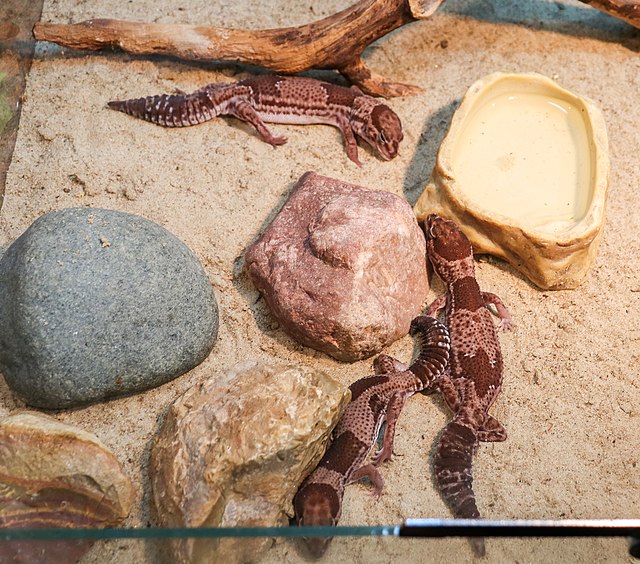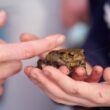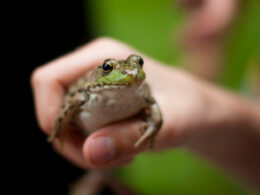In this article Show
When we talk about unique and fascinating reptiles, the African Fat-tailed Gecko often takes center stage. Native to the arid regions of West Africa, these little creatures have captured the hearts of many with their charming appearance and captivating behavior.
I’ve been an enthusiastic pet owner for years, spending countless hours unraveling the mysteries of reptile care. And if there’s one thing I’ve learned, it’s that understanding and replicating their natural habitat is key.
In this guide, we’ll explore everything you need to know about African Fat-tailed Gecko care. From their origin and diet to behavior and health concerns, this comprehensive guide has got you covered.
So, whether you’re a seasoned reptile enthusiast or a curious beginner, let’s embark on this journey together, ensuring that your gecko thrives under your care.
Housing and Habitat Setup

Creating an ideal environment for your African Fat-tailed Gecko is crucial. The closer we can mimic their natural habitat, the happier and healthier they’ll be.
According to a study published in the Journal of Herpetology, reptiles, including geckos, display enhanced physical activity and improved behavioral patterns when housed in an environment that closely resembles their natural habitat.
Choosing The Right Terrarium Size
For a single African Fat-tailed Gecko, a 10-gallon terrarium often suffices. However, if you plan to house more than one, consider increasing the size. A spacious environment prevents territorial disputes and ensures each gecko has adequate space.
Substrate Recommendations And What to Avoid
Reptile carpets, paper towels, and coconut fiber are excellent choices for substrate. They are easy to clean and safe for the gecko. On the flip side, avoid using sand, as it poses impaction risks if ingested.
The Importance of Hiding Spots, Climbing Structures, and Decorations
African Fat-tailed Geckos, by nature, are shy creatures. Providing them with multiple hiding spots, such as caves or overturned bowls, allows them to feel secure.
While they aren’t avid climbers like some other reptile species, a few low-climbing structures can offer physical enrichment. Adding plants and other decorations not only enhances the terrarium’s aesthetics but also contributes to the gecko’s well-being.
Temperature and Humidity Requirements
Maintaining the right temperature gradient is essential. The warm end of the terrarium should be between 85-90°F (29-32°C), while the cooler end should be around 75°F (24°C).
Nighttime temperatures can drop a few degrees but should remain above 70°F (21°C). As for humidity, aim for levels between 50-70%. Misting the terrarium lightly every few days can help maintain this range.
Diet and Nutrition
Feeding your African Fat-tailed Gecko a balanced and nutritious diet is paramount for its well-being. Understanding their dietary preferences in the wild provides insights into how we can best cater to their nutritional needs in captivity.
What African Fat-tailed Geckos Eat in The Wild
In their natural West African habitats, African Fat-tailed Geckos are insectivorous predators. They primarily feast on a variety of insects, including crickets, beetles, and moths. Occasionally, they might consume small arachnids like spiders.
Recommended Diet For Captivity
In a controlled environment, a mix of crickets, mealworms, and waxworms serves as the staple diet for these geckos. Dubia roaches and silkworms can also be introduced occasionally for variety.
It’s important to note that all feeder insects should be gut-loaded – that is, fed nutritious foods 24 hours before being offered to the gecko. This ensures that your pet gets maximum nutrition from each meal.
Feeding Frequency And Portion Size
Juvenile geckos have a faster metabolism, so they should be fed daily. Typically, 4-8 appropriately-sized insects per feeding session work well. For adult geckos, feeding them 3-4 times a week is sufficient. At each feeding, offer around 6-10 insects, depending on their size.
Supplements And Their Importance
Just like humans, geckos require certain vitamins and minerals to stay healthy. Calcium and vitamin D3 supplements are particularly vital. Dust the feeder insects with a calcium supplement at every feeding for juveniles and every other feeding for adults.
A vitamin D3 supplement should be used once a week for juveniles and once every two weeks for adults. This ensures proper bone growth and prevents metabolic bone disease, a common ailment in captive reptiles.
Behavior and Social Interaction
Understanding the behavior of the African Fat-tailed Gecko is essential, not just for the well-being of the gecko but also to ensure a positive interaction between the owner and the pet. Observing their behaviors can offer great insights into their health, mood, and overall well-being.
Typical Behaviors to Expect
African Fat-tailed Geckos are predominantly nocturnal, which means they are most active during the night and tend to be reclusive during the day. You might often find them hiding during daylight hours.
They use their tail, which stores fat, as a source of energy and nutrition during times when food is scarce.
If threatened, they might even drop their tail as a defense mechanism, although it will regrow over time, albeit not to its original form. They are generally calm and docile creatures but can display signs of stress through rapid breathing or skin darkening.
Differences Between Males and Females
Sexual dimorphism, while not glaringly obvious in African Fat-tailed Geckos, is present. Males tend to have broader heads, thicker necks, and more pronounced femoral pores (tiny bumps located on the underside near the base of the tail) compared to females.
Behaviorally, males can be more territorial, especially during the breeding season, while females might exhibit nesting behaviors when gravid.

Handling Techniques and Tips to Build Trust
Building trust with your gecko is vital for a stress-free interaction. Start by allowing your gecko to acclimate to its new environment for a week or so without handling. When you begin handling sessions, keep them short and gentle. Use slow movements to avoid startling the gecko.
Let the gecko walk from one hand to the other, ensuring you’re close to a soft surface in case of unexpected jumps.
Over time, as the gecko becomes accustomed to your presence, handling can become a more regular and enjoyable activity for both of you. Always remember, patience is key!
Health and Common Issues
Ensuring the health and well-being of your African Fat-tailed Gecko requires both observation and preventative measures. Recognizing early signs of health issues can make a huge difference in the overall outcome for your pet.
Signs of a Healthy Gecko
A healthy African Fat-tailed Gecko will have clear, bright eyes and a well-rounded tail, indicating good fat storage. Its skin should be free from mites, wounds, or irregular spots, and it should shed its skin completely and regularly.
A steady appetite and regular bowel movements are also indicative of a healthy gecko. Activeness during its nocturnal hours and a calm demeanor when handled are additional signs of good health.

Common Health Concerns and Treatments
1. Metabolic Bone Disease (MBD)
Caused by an inadequate diet, particularly a lack of calcium and vitamin D3, MBD leads to weak and deformed bones. It’s crucial to provide a balanced diet with the necessary supplements to avoid this.
2. Impaction
This happens when the gecko ingests indigestible material, like sand, causing a blockage. Using appropriate substrate and ensuring the gecko’s food is of the right size can prevent this. If suspected, consult a vet immediately.
3. Respiratory Infections
Indicators include wheezing, mucus around the nose and mouth, and labored breathing. This can be caused by incorrect humidity levels or drafts. Immediate veterinary care is essential.
4. Parasites
Internal parasites can lead to weight loss, irregular bowel movements, and a decreased appetite. External parasites like mites should be visible on the gecko’s skin. Regular check-ups with a reptile vet can help in early detection and treatment.
Preventative Care Tips
- Regular Vet Check-ups: Just like other pets, regular visits to a reptile-savvy vet can ensure your gecko is in tip-top shape.
- Maintain Cleanliness: Keeping the terrarium clean reduces the risk of bacterial and fungal infections. Regularly clean and disinfect the habitat.
- Proper Diet: Ensuring your gecko gets a balanced diet with the necessary supplements can prevent many health issues.
- Monitor Environment: Regularly check the temperature and humidity levels in the terrarium to ensure they are within the desired range.
- Isolation for New Pets: If introducing a new reptile to your collection, keep it isolated for a few weeks to monitor for potential diseases or parasites.
Breeding and Reproduction
The process of breeding African Fat-tailed Geckos is a delicate one, requiring both knowledge and attention to detail. Successful reproduction hinges on understanding their natural behaviors and replicating those conditions in captivity.
According to a study published in the Reptile and Amphibian Journal, captive breeding programs have seen the most success when the environmental conditions, diet, and behavioral needs of the species are meticulously met.
Breeding African Fat-tailed Geckos can be an exciting venture for reptile enthusiasts. Whether you’re aiming for specific color morphs or simply want to experience the joy of hatchlings, it’s essential to understand the basics of their reproductive behavior and needs.
Understanding The Breeding Cycle
African Fat-tailed Geckos typically reach sexual maturity around 9-12 months of age. Their breeding season often starts in the late winter and can extend into early summer.
Before initiating breeding, it’s recommended to have a cooling period (brumation) of about 4-6 weeks where temperatures are slightly lower than usual, simulating the conditions in their natural habitat.
Once this period is over, increasing the temperature and introducing the male to the female can stimulate breeding behavior. Females can lay multiple clutches of eggs in a season, usually consisting of 1-2 eggs per clutch.
Tips For Breeding in Captivity
- Healthy Breeders: Ensure that both the male and female are healthy, with optimal weight, and free from any diseases or parasites.
- Separate Housing: It’s a good practice to house males and females separately and introduce the male to the female’s terrarium for breeding.
- Recognizing Mating Behavior: The male may vocalize, nuzzle, or even nip the female’s tail during courtship. After successful mating, it’s advisable to separate them again.
- Nesting Box: Providing a moist nesting box filled with vermiculite or moss can offer the female a suitable place to lay her eggs.
Caring For Eggs And Hatchlings
- Incubation: Once the eggs are laid, they can be gently transferred to an incubator set at 82-88°F (28-31°C). The exact temperature can influence the gender of the hatchlings, with warmer temperatures often producing females and cooler ones producing males.
- Monitoring: It’s essential to maintain a consistent temperature and moderate humidity in the incubator. The eggs should be checked regularly for mold or any irregularities.
- Caring for Hatchlings: After 55-70 days, the eggs will hatch. Hatchlings should be kept in individual enclosures to monitor their health and feeding.
Baby geckos can be started on pinhead crickets and tiny mealworms. They will also benefit from calcium and vitamin supplements to support healthy growth.
Fun Facts and Trivia
Everyone loves some interesting tidbits about their favorite pets! Let’s dive into some quirky and fascinating facts about the African Fat-tailed Gecko.
Unique Characteristics of the African Fat-tailed Gecko
Regenerative Tail
Much like other geckos, African Fat-tailed Geckos have the unique ability to drop their tail as a defense mechanism against predators. What’s more, they can regrow it, though the new tail might not look exactly like the original.
Sensitive Hearing
These geckos have no external ear opening but possess an incredible sense of hearing. They have a transparent window in the skull behind their eyes, which lets them detect vibrations and sounds.
Eyelid Wonders
Unlike many of their gecko cousins who have fixed eyelids and use their tongues to clean their eyes, African Fat-tailed Geckos have functional eyelids that they can blink with.
How They Got Their Name
The name “Fat-tailed” comes from their thick, chubby tail, which serves more than just a decorative purpose. This tail acts as a storage unit for fat, allowing the gecko to tap into these reserves during times of food scarcity, much like a camel’s hump. Over time, this distinct feature became emblematic of the species, leading to its popular name.
Other Interesting Tidbits
Mood Ring Effect
African Fat-tailed Geckos can slightly alter their color based on their mood, temperature, and health. For instance, a darkened color might indicate stress or cooler temperatures.
Nocturnal Ninjas
While they might seem calm and docile during the day, come nighttime, these geckos are active and agile hunters, stealthily stalking their insect prey.
Sibling Bonds
If eggs are incubated together and hatch around the same time, the hatchlings can often be seen huddled together for warmth and comfort during their initial days.









